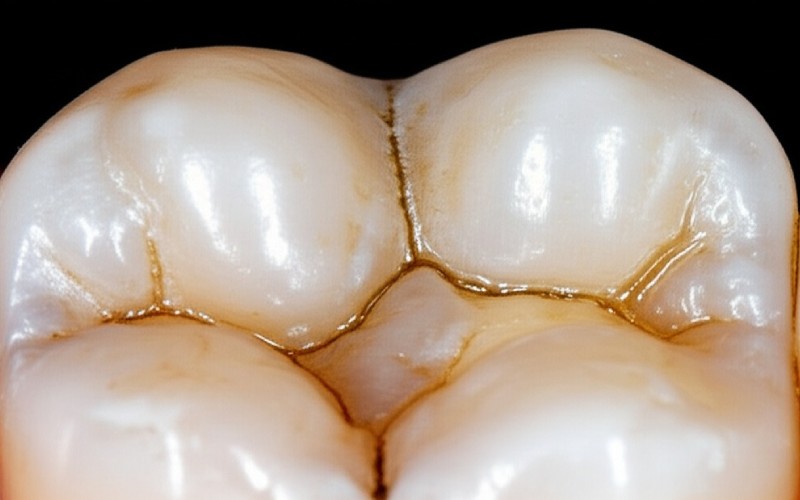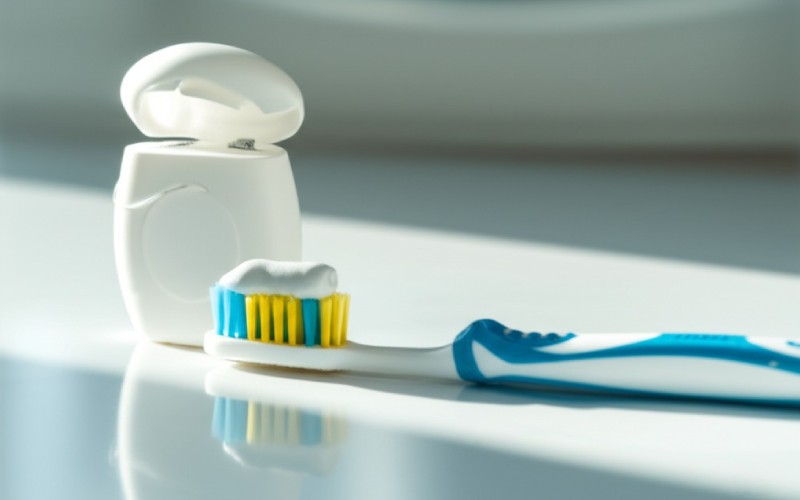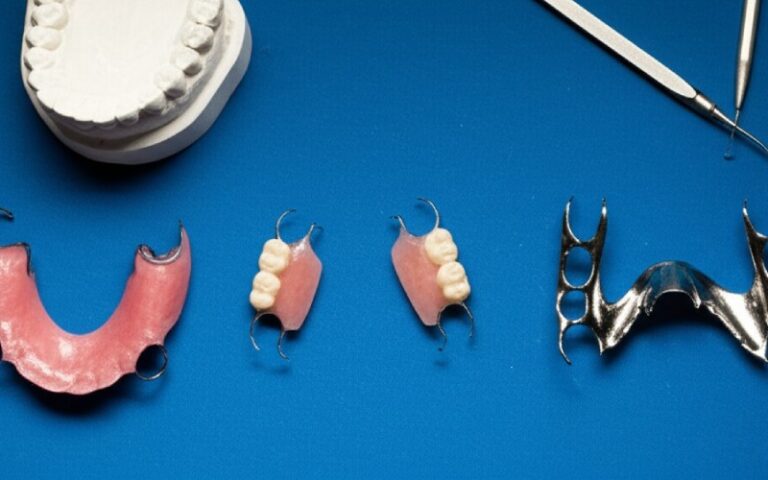
Il tuo smalto dentale è danneggiato? Guida per comprendere e arrestare l'erosione dello smalto
When your enamel is damaged, it’s gone for good. But you can stop more damage from happening. In this article, you will find out what tooth enamel is, why it’s so important, and what the signs of damaged enamel are. Most importantly, I’ll show you easy ways to protect your teeth from tooth enamel erosion and keep your smile healthy and strong.
Indice dei contenuti
What Exactly is Tooth Enamel and Why is It So Important?
Think of it as a super-strong shield for your teeth. In fact, tooth enamel is the hardest substance in your entire body. It’s the outer covering of the tooth. This thin but tough layer has a very important job. Enamel protects the sensitive parts inside your teeth from daily life. This includes things like chewing, biting, and temperature changes. The importance of tooth enamel can’t be overstated. It’s your first line of defense.
This protective layer of enamel is what keeps your teeth looking white and bright. The enamel is the protective shield against things that cause pain and problems. When this enamel is the thin outer covering, it keeps your smile looking great and your teeth feeling good. Without strong tooth enamel, your teeth would be in trouble. Keeping this shield strong is key to having healthy teeth. In fact, tooth enamel is the hardest material we have, so we need to take care of it.
How Can I Tell if My Tooth Enamel is Damaged?
Feeling a zing of pain after drinking a cold glass of water is a classic sign of damaged enamel. One of the first signs is tooth sensitivity. You might feel pain when you eat or drink something hot, cold, sweet, or acidic. This happens because the wear and tear on your tooth enamel has exposed the layer underneath.
Another big clue is the color of your teeth. As the enamel wears away, the yellowish layer underneath, called dentin, starts to show through. This can cause discoloration of the teeth, making them look yellow. You might also see that your teeth look rounded or have small dents on the chewing surfaces. In the later stages of enamel damage, you might even see cracks and chips. It’s a clear sign that your enamel is damaged.

What are the Main Causes of Enamel Erosion?
So, what causes this problem? There are several causes of enamel erosion. The biggest one can be your diet. Eating a lot of acidic foods and beverages can really erode the enamel. This includes things like soda, fruit juices, and even some fruits and candies. These foods and drinks create an acid erosion effect in your mouth that slowly dissolves your enamel.
But it’s not just about what you eat. Some people grind their teeth at night, which causes a lot of wear and tear. Certain medical conditions, like acid reflux, can also contribute to enamel loss because stomach acid comes up into your mouth. There is also a rare condition called enamel hypoplasia, where the enamel doesn’t form correctly. All these things can erode the protective layer of your tooth enamel. The result is enamel erosion.
Is Acid the Biggest Enemy of Your Tooth Enamel?
In a word, yes. Acid is the number one enemy of your tooth enamel. When you eat or drink acidic things, the acid attacks the enamel on your teeth. This process is called dental erosion. Every time you have an acidic beverage or food, your mouth becomes a battleground. The acid starts to soften and dissolve the minerals right out of your tooth’s enamel.
This is why your dentist recommends you cut back on soda. It’s full of acid that causes terrible enamel erosion. Even healthy foods like lemons and oranges are very acidic. The goal isn’t to avoid these foods completely, but to be smart about them. After you have something with acid, it’s a good idea to rinse your mouth with water. This helps to wash away the harmful acid and gives your enamel on teeth a fighting chance. It’s a simple step that can prevent serious enamel erosion.
How Does Plaque Lead to Tooth Decay and Enamel Loss?
Let’s talk about plaque. Plaque is a sticky film of bacteria that is always forming on your teeth. When you eat sugary or starchy foods, the bacteria in your mouth feed on the sugars and food particles. As they feed, they produce acid. This acid attacks your tooth enamel. If the plaque isn’t removed by brushing, the acid will continue to eat away at the enamel. This is how a cavity starts to form.
This is the direct link between plaque and tooth decay. The constant acid attack from plaque weakens the enamel, which can lead to tooth enamel loss. Over time, this enamel damage can lead to a cavity. Tooth decay is a common problem, but it starts with this process. If left untreated, severe tooth decay can lead to tooth infections and even tooth loss.
Can My Dentist Really Help with Damaged Tooth Enamel?
Absolutely. Your dentist is your best partner in this fight. Regular visits to the dentist are so important for your oral health. They can spot the early signs of enamel erosion before you even notice them. This gives you a chance to make changes before the damage gets worse.
A dentist does more than just clean your teeth. They provide crucial dental care and advice. They will check your teeth and gums and can recommend specific products or treatments to help protect your teeth. They might suggest a special toothpaste or rinse. Following your dentist’s advice for taking care of your teeth is the best way to maintain healthy teeth and gums. Your regular dental checkup is a key part of your health plan. Good dental health is part of your overall health. That’s why these dental visits are so important.
What Are the Best Ways to Prevent Enamel Erosion?
Now for the good news. You can take action to prevent enamel erosion. One of the best things you can do is to practice good oral hygiene. This helps to reduce the risk of enamel damage. Your own body helps, too. Your saliva is your mouth’s natural defense. It helps to wash away food and acid, and it has minerals that can help strengthen teeth. Chewing sugar-free gum can help you make more saliva.
Using a fluoride toothpaste is also very important. Fluoride is a mineral that helps to make your tooth enamel stronger and more resistant to acid attacks. Limiting sugary and acidic foods and drinks is another huge step. When you do have them, drink water afterward to rinse your mouth. Good oral hygiene and smart food choices are your best tools to prevent erosion and stop enamel erosion in its tracks.
Does the Way I Brush My Teeth Affect My Enamel?
Yes, how you brush matters a lot. Brushing too hard can actually wear down your tooth enamel. You should always use a soft-bristled toothbrush. Think of it as gently polishing your teeth, not scrubbing a floor. It’s best to brush your teeth for two minutes, twice a day.
Make sure your oral hygiene routine is consistent. Brushing your teeth twice a day helps remove the plaque and bacteria from your teeth before they can produce harmful acid. And don’t forget about brushing and flossing. Flossing gets rid of the plaque between your teeth where your brush can’t reach. A good oral hygiene habit is to brush gently and floss daily. Making sure you brush your teeth twice a day is one of the simplest and most effective things you can do.

What Are the Treatment Options for Tooth Enamel Erosion?
If you already have some enamel erosion, don’t worry. There are treatment options available to help. For minor cases, your dentist might suggest an enamel repair process using fluoride treatments. These can help to strengthen teeth and restore minerals to the weakened enamel. This is a great way to protect your teeth from more damage.
In more severe cases, where the layer of enamel is very thin or gone, your dentist might recommend other treatment options. One common option is tooth bonding. This is when a tooth-colored resin is applied to the tooth surface to cover the damaged area. It looks natural and protects the tooth. For a great smile, some people consider teeth whitening, but you should talk to your dentist first if you have weak enamel. The goal of any treatment is enamel repair and preventing future problems.
How Can I Prevent Tooth Decay for Good?
The best way to prevent tooth decay is to be proactive. It all comes down to a solid oral hygiene routine and smart choices. Enamel is the first line of defense against tooth decay, so protecting it is everything. This means brushing with fluoride toothpaste and making sure you floss every single day. When you floss, you remove plaque from tight spots, which is a big step to prevent tooth decay.
Pay attention to your diet. Limit sugary and starchy foods and beverages. When you eat them, try to do so with a meal instead of snacking all day. This gives your mouth a break from acid attacks. Seeing your dentist for regular cleanings and checkups will help you stay ahead of any problems. If you follow these steps, your teeth become stronger and healthier. You can have healthy teeth and a smile you are proud of. When you keep your teeth strong, you build a great defense for your teeth. Floss regularly to keep them clean.
Punti chiave da ricordare
- Your tooth enamel is the hard, outer shield that protects your teeth. Once it’s gone, it doesn’t grow back.
- Acid from foods and drinks is the number one cause of enamel erosion, which can lead to tooth decay.
- Signs of damage include tooth sensitivity, yellowing teeth, and dents on the tooth surface.
- Brush gently with a soft brush and a fluoride toothpaste twice a day to remove plaque.
- Limit acidic foods and drinks. When you have them, rinse your mouth with water afterward.
- Visit your dentist regularly for checkups. They can spot problems early and offer treatment options.




